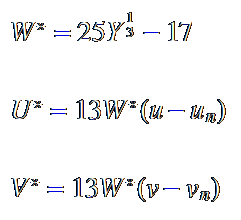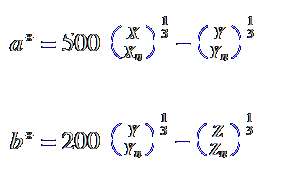| Colors:: | |||
|---|---|---|---|
The CIE - "La Commission Internationale de l'Éclairage" The International Commission on Illumination (CIE) is an organisation devoted to international co-operation and exchange of information among its member countries on all matters relating to the art and science of lighting. Its membership consists of the National Committees in 39 countries and of 11 individual members. The objectives of the CIE are:
The CIE is recognised as the authority on all aspects of light and lighting. As such it occupies an important position among international organisations. |
|||
In 1931 the CIE developed the XYZ colour system, also called the "norm colour system." This system is often represented as a two-dimensional graph which more or less corresponds to the shape of a sail. The CIE colour standard is based on virtual primary colours XYZ (tristiumuls values) which do not exist physically. They were originally derived from the colour matching stimuli R, G and B (red, green, blue: 700, 546.1 and 435.8 nm) such that the XYZ values are positive for any colour which was not possible with RGB.
X, Y and Z are, however, purely theoretical in contrast to colour gamuts such as RGB or CMYK (cyan, magenta, yellow, black). These primary colours have been selected such that colours which can be perceived by the human eye lie within their colour space. The XYZ system is based on the response curves of the eye's three colour receptors. Since these differ slightly from person to person, the CIE has defined a "standard observer" whose spectral response corresponds more or less to the average response of the population. This objectifies the colourimetric determination of colours. The three primary colours of the CIE XYZ reference system call for a spatial model with coordinates X, Y and Z, which can be drawn as a chromaticity triangle. To arrive at a two-dimensional diagram (see Fig. 1), this chromaticity triangle is projected into the red-green (X/Y) plane.
A colour is not fully defined by its chromaticity (x and y). A brightness coefficient also needs to be specified as well. |
|||
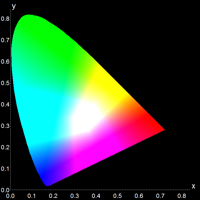 |
|||
| Fig. 1: The CIE1931 XY colour plane | |||
 |
|||
| Fig. 2: The CIE1976 u'v' colour plane | |||
| The CIE 1976 uniform colour space Although the x, y chromaticity diagram has been widely used, it suffers from a serious disadvantage: the distribution of the colours on it is not uniform. This is illustrated in Fig. 3: Each of the short lines in this figure joins a pair of points representing tow colours having perceptual colour difference of the same magnitude, the luminances of all the colours being the same. Ideally these identical colour differences should be represented by lines of equal length. But it is clear that this is far from being the case, the lines being much longer towards the green part of the spectral locus, and much shorter towards the violet part, than the average length. In Fig.4 a different chromaticity diagram is used, in which the lines of Fig. 3 are shown again. It is immediately clear that the variation in the length of the lines, while not eliminated, has been much reduced; in fact, the ratio of the longest to the shortest line in Fig. 4 is only about four to one, instead of about twenty to one in Fig.3. The chromaticity diagram shown in Fig.4 (and in Fig. 2) is known as the „CIE 1976 uniform chromaticity scale diagram", commonly referred to as the „u', v' diagram". It is obtained by plotting u' against v' , where: The u', v' diagram is useful for showing the relationships between colours whenever the interest lies in their discriminability. Chromaticity diagrams have many uses, but, as they show only proportions of tristimulus values, and not their actual magnitudes, they are only strictly applicable to colours all having the same luminance. In general, colours differ in both chromaticity and luminance, and some method of combining these variables is therefore required. To meet this need, the CIE has recommended the use of one of two alternative „colour spaces". The first of these spaces to be considered is the „CIE 1976 (L*u*v*) colour space" or the „CIELUV" colour space. It is produced by plotting, along three axes at right angles to one another, the quantities: where u'n , v'n are the values of u', v' for the appropriately chosen reference white. Here, L* denotes the lightness of the colour, ranging from zero (black) to 100.For Y/Yn > 0.008856: For Y/Yn <= 0.008856: In order to calculate the „General Colour Rendering Index" colour distances in a similar colour space are used: The „1964 Uniform Colour Space". It is based on the u, v chromaticity diagram, which is very similar to the u', v' diagram (u=u', v=v' ). In this colour space the lightness is presented by W* ; U* and V* are again the chromaticity co-ordinates: |
|||
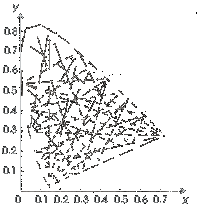 |
|||
| Fig. 3: Uniformity within the CIE1931 XY colour plane | |||
 |
|||
| Fig. 4: Uniformity within the CIE1931 u'v' colour plane | |||
The CIE L* a* b* colour space While the human eye at first registers three colour stimuli relating to red, green and blue light, in a further (brain-) processing stage three sensations are generated: a red-green sensation, a yellow-blue sensation and a brightness sensation. These sensations are used to develop the „complementary colour system" or „CIE L*a*b* colour system". It is based on differences of two elementary colour pairs: red-green, yellow-blue as well as the brightness „pair" black-white (Fig. 5). Hue and chroma are defined by the coordinates a and b which can have both positive and negative values. The third characteristic, brightness, is represented vertically by means of a brightness scale designated L* with scale values ranging from 0 (black) to 100 (white). The formulas for the transformation of xyz to CIE L*a*b* are:
|
|||
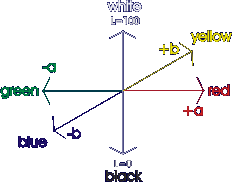 |
|||
| Fig. 5: The CIE L*a*b* colour space, based on the differences of two elementary colour pairs red-green (a) and blue-yellow (b). The brightness is taken into account by the L value that ranges from 0 (black) to 100 (white). | |||
 |
|||
The General Colour Rendering Index where u and v denote the colour coordinates in the 1960 CIE uniform chromaticity diagram. If the chromaticity difference between the lamp to be tested and the reference illuminant is greater than a given maximum tolerance of 5,4*10-3 µK-1 the resulting Colour Rendering Index may be expected to become less accurate. |
|||
| Fig. 6: RGB approximations of the 8 CIE test colours used to calculate the colour rendering index (Ra) | |||
Different colour rendering under differnet white light sources Yttrium aluminium borate (YAB) is a well-known host for metal ions. Rare-earth and transition metal doped materials can be used as lasers because of their outstanding optical properties and have been investigated. In YAB, The Y3+ ions are located in trigonal prismatic sites with D3 symmetry, the metal ion is co-ordinated to three oxygen atoms from the borate top and bottom layers, where the two triangles are slightly rotated against each other. The Al3+ sites show almost perfect octahedral symmetry. Upon doping, the rare earth ions replace yttrium ions whereas transition metal ions such as Cr3+ are substituted for Al3+. For most of the optical applications of the YAB system the luminescence properties of the doped materials are of importance. The co-doped materials Ho,Nd:YAB, Ho,Cr:YAB, Nd,Cr:YAB and Ho,Nd,Cr:YAB reveal interesting colour rendering properties. In this context it is their absorbance, which gives rise to their colour change. Holmuim and Neodymium sesquioxides already show slight colour differences between daylight and fluorescent tube illumination. This perceptual colour difference is enhanced drastically when these elements are used as dopants in the YAB host. Furthermore, their combination in the same host increases the variety of colours - an effect which cannot be achieved by simply mixing the oxide powders. Chromium shows strong absorptions in the visible range. In combination with Ho3+ and Nd3+, Cr3+ enhances the crystals’ hue. Ho:YAB, for instance, is yellowish brown in daylight and pink when illuminated with a type 840 fluorescent tube. If Cr3+ is added, the crystal will still look pink in the latter case but will be dark green in daylight. An example of the different chromaticity co-ordinates of the crystals is given in Fig. 7. |
|
||
| Fig. 7: Ho,Nd:YAB crystal chromaticities in the CIE1931(xy) chromaticity plane. The numbers indicate the illumination with the different light sources: 1: fl. lamp type 32, 2: fl. lamp type 33 3: fl. lamp type 840 4: fl. lamp type 960 5: white LED, 6: tungsten lamp, 7: daylight CIE D5500 | |||
Crystal colours The colours of Nd,Ho:YAB; Cr,Ho:YAB; Nd,Cr:YAB and
Cr,Nd,Ho:YAB under illumination with seven different
white light sources are shown in Fig. 8. The materials change
their colour upon illumination with different white light
sources so dramatically that they could be used for light
source discrimination; the microcrystalline powders on
the other hand could be used as novel coating materials
with a colour changing effect that depends on the
spectral distribution of the illuminating light source. Literature: Links: |
|
||
| Fig. 8: Ho,Nd:YAB; Ho,Cr:YAB and Nd,Cr:YAB crystals under illumination with three different white light sources: a fluorescent lamp type 840, a tungsten lamp, and a white LED | |||






